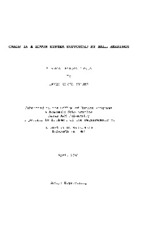| dc.creator | Fisher, James Robert, 1979- | |
| dc.date.accessioned | 2013-02-22T20:41:21Z | |
| dc.date.available | 2013-02-22T20:41:21Z | |
| dc.date.created | 2001 | |
| dc.date.issued | 2013-02-22 | |
| dc.identifier.uri | https://hdl.handle.net/1969.1/ETD-TAMU-2001-Fellows-Thesis-F55 | |
| dc.description | Due to the character of the original source materials and the nature of batch digitization, quality control issues may be present in this document. Please report any quality issues you encounter to digital@library.tamu.edu, referencing the URI of the item. | en |
| dc.description | Includes bibliographical references (leaf 31). | en |
| dc.description.abstract | Nonlinearities in a system are often thought of as unimportant and negligible. It is only recently that many of the impacts of nonlinearities in a system are being fully realized. One of these impacts is chaos. Chaos is a bounded steady state behavior that appears to be random, yet has some sort of order associated with it. Much work has been carried out in observing chaos analytically, however there is little experimental work in existence. In addition, there has been little work applied to observing chaos in rotor systems. Further, there has been little work carried out in the area of chaos control, of which only a small portion has been applied to rotor systems. Originally, the goal of the research described in this paper was to control the chaotic response observed previously in a rotor system by Ortiz (Ortiz 2000). However, it soon became clear that the chaotic response was not as strong as previously believed, and may have been attributed to extraneous conditions. The goal then became to exploit other nonlinearities to observe a chaotic response. This work was successful. The same rotor system used by Ortiz in his research was used again for this research. Chaos was observed by examining the case where the bearings supporting the rotor vibrate in their mounts. By loading the rotor and examining its response at various speeds, it was discovered that a chaotic response was observed. As the rotor speed increases, the response alternates between "chatter" and chaotic behavior. A control was also attempted using an attempt of Occasional Proportional Feedback as described by Barr, Myneni, Corron, and Pethel, but work was unsuccessful. | en |
| dc.format.medium | electronic | en |
| dc.format.mimetype | application/pdf | |
| dc.language.iso | en_US | |
| dc.publisher | Texas A&M University | |
| dc.rights | This thesis was part of a retrospective digitization project authorized by the Texas A&M University Libraries in 2008. Copyright remains vested with the author(s). It is the user's responsibility to secure permission from the copyright holder(s) for re-use of the work beyond the provision of Fair Use. | en |
| dc.subject | engineering. | en |
| dc.subject | Major engineering. | en |
| dc.title | Chaos in a rotor system supported by ball bearings | en |
| thesis.degree.department | engineering | en |
| thesis.degree.discipline | engineering | en |
| thesis.degree.name | Fellows Thesis | en |
| thesis.degree.level | Undergraduate | en |
| dc.type.genre | thesis | en |
| dc.type.material | text | en |
| dc.format.digitalOrigin | reformatted digital | en |


